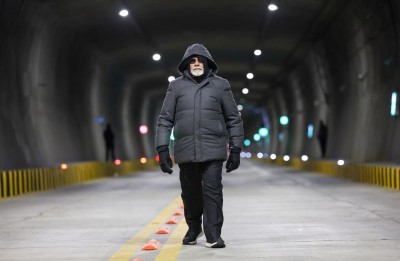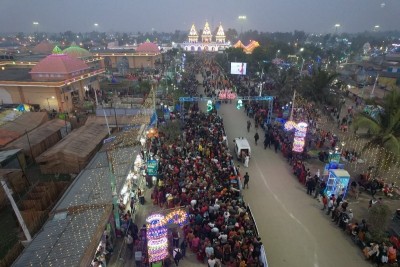January 23, 2025 04:57 pm (IST)

India moved ahead from disaster mitigation to risk reduction: Rajnath
New Delhi, Nov 17 (IBNS): Union Home Minister Rajnath Singh has said that India has moved ahead from disaster mitigation to risk reduction.
Addressing the inaugural session of the Asia Leaders’ Meeting towards Implementation of the Sendai Framework for Disaster Risk Reduction in Asia and 2nd International Strategy for Disaster Reduction (ISDR) Asia Partnership (IAP) meeting of 2015 here on Tuesday, Singh said that multi-dimensional aspects of disaster related risks should be dealt with affirmative action.
During the inaugural session, Margarete Wahlstrom, Special Representative of the United Nations Secretary General for Disaster Risk Reduction, conferred the Union Minister of State for Home Affairs, Kiren Rijiju, as the Asia Leader for Disaster Risk Reduction (DRR) on behalf of the United Nations Office for Disaster Risk Reduction (UNISDR).
Rijiju was conferred as the first regional champion for DRR after the Sendai Agreement, giving an impetus to Government of India’s efforts to facilitate regional support towards enabling community resilience in the Asia-Pacific region.
The function was attended by Ministers from China, Indonesia, Japan, Malaysia, Mongolia, South Korea and Thailand, delegates from various countries and international organizations.
Accepting the honour, Rijiju said: “This recognition is an onerous responsibility on India and in my personal capacity to make India, Asia-Pacific and the world as a whole safer and better prepared to deal with any disaster.”
“We recognize the importance of including disaster and climate risk management as an integral part of developmental planning and programs to realize the global goals of sustainable development and poverty eradication,” he said.
Rijiju said countries in the Asian region have been “building back better” in the face of inexorable disasters.
Lauding Rijiju upon being conferred as the Asia Champion for DRR, Singh said his constant efforts have resulted into recognition of India as DRR regional Champion by the United Nations.
The Union Home Minister said India has been drawing the best practices around the World to improve its system and processes for Disaster Management. Our national policies include mainstreaming of disaster risk reduction and development programs, besides community resilience building, he added.
“We have been actively pursuing a paradigm shift in disaster management from a relief centric approach in the past to a holistic one, that encompasses preparedness, prevention, mitigation and risk reduction. We have established robust Institutional structures from National to provincial level with legislative back up and policy framework for enhancing our capabilities to reduce risk and loss to economy,” said Singh.
Calling upon all entities, public and private, to strengthen the international support mechanisms for disaster risk reduction by sharing of reliable and affordable modern technology for capacity-building, the Union Home Minister hoped the Asia Ministerial Meeting and IAP meeting will set the agenda for the First Asia Ministerial Conference for Disaster Risk Reduction (AMCDRR) after the advent of the Sendai Framework for Disaster Risk Reduction (SFDRR) due be held in New Delhi in November next year.
“At the Third UN World Conference on Disaster Risk Reduction held in Sendai, Japan earlier this year, we committed to support a 15-year plan (2015-2030) of action with defined global targets and priorities under the Sendai Framework for Disaster Risk Reduction,” he said.
Singh hoped the meeting would help devise future strategies for identification of risks, challenges and equal distribution of scarce resources ultimately contributing to achieve sustainable development goals.
“Systematic incorporation of risk mitigation, emergency preparedness and capacity building approaches into national policy framework and developmental programs would not only strengthen institutional mechanism but inculcate awareness among masses, in particular the law making entities,” he said.
The Union Home Minister said the ISDR Asia Partnership forum is a vital space for our governments to collectively reflect and share experiences on best practices and innovative solutions to implement disaster risk reduction effectively at national and local levels across the Asia region.
Earlier Rijiju said that as partners, we can use this platform to collaborate on responsibilities and make actionable commitments towards implementation of our shared goal of disaster risk reduction.
“As Asia Leader, we will work toward converging individual efforts of member states into a larger inclusive and collaborative mechanism for recovery, rehabilitation and rebuilding of affected communities and assets,” he said.
Underlining that the Asia-Pacific region is the most disaster-prone area in the world, Rijiju pointed out that many Asian countries have experienced fast economic growth over the last decades, which coupled with high population growth and rapid urbanisation, has exposed the large vulnerable population and their habitats as well as economic assets to hazards, creating huge risks of disasters which is further exacerbated by climate change.
Acknowledging the importance of private sector participation in disaster risk reduction, said the Global Assessment Report by UNISDR has highlighted the fact that the relationship between business investments practices and disaster risk reduction needs to be strengthened in order to reduce economic losses. In fact, our National Policy on Disaster Management too recognizes the role of private sector and encourages public- private partnerships for disaster risk reduction, he added.
Reiterating India’s commitment towards forging regional cooperation in the field of disaster risk reduction, Rijiju said all the South Asian countries are working together to achieve the target of reduced disaster risk by promoting knowledge sharing among the SAARC countries.
Citing capacity building by India over the years, Rijiju said we are keen to share our expertise and help other countries in disaster response and capacity building as we did during Japan Earthquake in 2011.
“Development of scientific applications like Indian National Centre for Ocean Information Services (INCOIS), the Tsunami Early Warning System (TEWS), which is a State-of-the-Art warning system, are benefitting not only India but also the littoral countries of Indian Ocean,” he said.
The Special Representative to the Secretary General of the United Nations, Margareta Wahlstrom, in her opening remarks, stressed the importance of regional partnerships as a foundation for the effective implementation of the SFDRR over the next 15 years and the need to make risk the DNA of all development plans, to integrate DRR in all development programmes and to have measurable indicators. A multi-hazard and mutli-sectoral approach needs to be adopted to reduce disaster risks, she said.
“Strengthening the resilience of communities, especially of marginalized and disadvantaged groups, to be able to build back better, will be critical for the realization of the SFDRR,” said. Wahlstrom. “Given the high vulnerability of the Asian region to disasters, it is of paramount importance that countries in this region own and collaborate to implement a regional plan for DRR under the Sendai Framework,” she added.
Support Our Journalism
We cannot do without you.. your contribution supports unbiased journalism
IBNS is not driven by any ism- not wokeism, not racism, not skewed secularism, not hyper right-wing or left liberal ideals, nor by any hardline religious beliefs or hyper nationalism. We want to serve you good old objective news, as they are. We do not judge or preach. We let people decide for themselves. We only try to present factual and well-sourced news.
Support objective journalism for a small contribution.
Latest Headlines
Indian couples in US rush for C-sections as deadline for Trump's law ending birthright citizenship nears
Thu, Jan 23 2025
'Will accept an auto rickshaw but not reward': Driver who rushed wounded Saif Ali Khan to hospital
Thu, Jan 23 2025
'He was dancing while walking': Maharashtra minister Nitesh Rane doubts Saif Ali Khan's stabbing incident
Thu, Jan 23 2025
JDU sacks Manipur Chief after he declares to withdraw support from BJP government in state
Wed, Jan 22 2025
12 dead after passengers jump off train in Maharashtra over rumours of fire and collision with another train
Wed, Jan 22 2025







